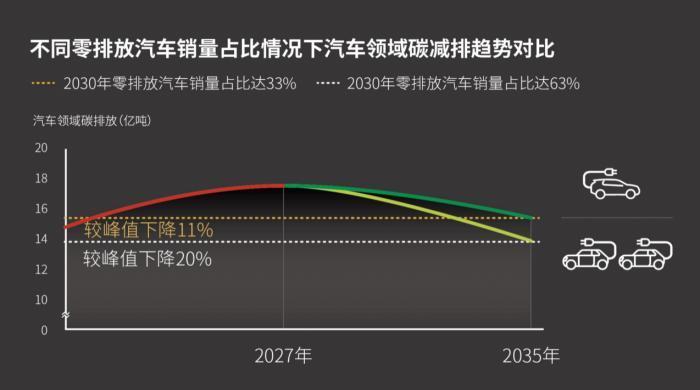On January 18, 2022, the international environmental protection agency Greenpeace and the All-China Environmental Protection Federation jointly released the report "Transformation and Challenges - How the Transformation of Zero-Emission Vehicles Can Help China's Automotive Sector Carbon Peak and Carbon Emission Reduction", predicting the carbon peak and carbon emission changes in China's automotive sector.
The report pointed out that under the existing policy scenario, the automotive sector will face a lack of emission reduction after the carbon peak, and the proportion of zero-emission vehicles represented by electric vehicles needs to be greatly increased. The report calls on major auto companies to accelerate the production and sales of zero-emission vehicles, stop selling fuel vehicles in the Chinese market by 2030, and achieve zero-emission transformation as soon as possible.
Since China proposed the "3060 Double Carbon Target", it has become a consensus of all walks of life to actively respond to climate change and achieve carbon peak carbon neutrality as soon as possible. As an important source of carbon emissions, the progress of carbon reduction in the automotive sector will significantly affect the achievement of China's dual carbon target. In 2021, the sales of new energy vehicles in mainland China reached 3.521 million units, ranking first in the world for seven consecutive years. But even so, carbon neutrality in the automotive sector still has a long way to go.
Emission reduction in the automotive sector after carbon peaking is weak
The report predicts that under the existing policy scenario, the automotive sector is expected to achieve a carbon peak around 2027, with a peak of 1.746 billion tons. After reaching the peak, it will not decline immediately, but will form a three-year emission platform period, during which the average annual carbon emission change is less than 1%. According to the analysis of different models, the carbon emissions in the passenger car field will peak in 2027, with annual emissions of about 940 million tons when they reach the peak; the carbon emissions in the passenger car field have reached a peak and will maintain a trend of decreasing year by year; the carbon peak time in the truck field will be 2028, and the annual emissions will be 719 million tons when it peaks.

According to the analysis of the report's data, carbon emissions in the automotive sector will fall by 11% from the peak in 2035. However, this reduction is still far from helping China's carbon neutrality goal. Assuming that the automotive sector wants to achieve carbon neutrality by 2060, the average annual carbon emission reduction in the automotive sector needs to reach a peak-to-peak amount of about 3% between 2027 and 2060, and the carbon emissions of the automotive sector in 2035 need to be reduced by at least 20% compared with the peak-to-peak in 2027, otherwise it will affect the automotive sector to achieve carbon neutrality by 2060.
To achieve this reduction, zero-emission vehicles should account for at least 63% of new cars sold in 2030 and at least 87% by 2035. The report calls on relevant policy-making departments to increase the proportion of zero-emission vehicle sales and strengthen the investment in relevant supporting infrastructure to support the rapid growth of zero-emission vehicles.
The share of zero-emission vehicle sales needs to be significantly increased
The report points out that the transformation of zero-emission vehicles is an important starting point for achieving emission reduction in the automotive sector at present.
To achieve these carbon reduction targets, zero-emission vehicles should account for at least 63% of new vehicles sold by 2030. However, in the Chinese auto market, some auto companies that have announced zero-emission vehicle sales targets for 2030 have not reached this level.
According to incomplete statistics, by 3030, the sales target of Volkswagen brand new energy vehicles is 50%, which needs to be increased by 13%; Honda's sales target is 40%, which needs to be increased by 23%; while toyota, GM, BMW and other major car companies have not yet announced the relevant targets for zero-emission vehicle sales in the Chinese market.
To achieve the goal of reducing carbon emissions from peak carbon emissions in the automotive sector by 20% by 2035, the report analyzes the compound annual growth rate of zero-emission vehicle sales required by major automakers between 2020 and 2030.
Among them, the sales of zero-emission vehicles of major joint venture brand manufacturers such as Volkswagen, Toyota, Honda, Nissan, Mercedes-Benz, BMW and Hyundai-Kia need to maintain an average annual compound annual growth rate of 60%. Compared with the above-mentioned joint venture brand car manufacturers, China's independent brand car manufacturers need relatively little growth pressure due to the relatively high proportion of electric vehicle sales, and the average annual compound growth rate of SAIC, Changan, Great Wall, Geely and Dongfeng is about 34%.
Judging from data analysis, in terms of carbon emission reduction in the transportation sector, joint venture brand automakers are facing greater pressure to transform from zero emissions. In this regard,
Bao Hang, head of Greenpeace's zero-carbon transportation project, said that major car companies should accelerate the zero-emission transformation in the Chinese market and stop selling fuel vehicles as soon as possible. Especially multinational car companies with important influence in the market, they should take the initiative to assume their corresponding carbon emission reduction responsibilities and make corresponding commitments.